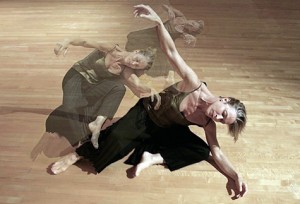When Performance Shatters Me
Editor’s note: This month on Stance on Dance, several dance artists have been asked to share a pivotal dance experience that changed their trajectory or the way they think about dance.
BY CHRISTIAN BURNS
Standing in a lightless arena-sized room (the blackness representing everything I don’t know) holding a flashlight that illuminates a cone of modest visibility (representing my current world view), I wander about. Without warning – KABOOM!!!#&*@!! – a performance shatters me – my flashlight is suddenly bigger – and a tiny bit of that black void is pushed back revealing new details and vantage points. This is how those rare moments feel when a performance shakes me from the familiarity of everything I thought I understood, gifting me with a new set of eyes, a rejuvenated heart and a humbled sense perspective.
Change that instant should be accompanied with a warning label: “Symptoms may include nausea, lightheadedness, headaches, stomach cramps, sleeplessness, vomiting, diarrhea and dry mouth.” Sometimes I’ve felt immediate giddiness, once I wept silently, and on occasion I felt the disorienting combination of having been punched in the stomach while cuddling in a post-coital haze of joy, all at once. That deep-seeded relief of having seen the thing I hadn’t realized existed but intuitively longed for; it’s a rare and precious occurrence.
Here are four important experiences that shattered me:
1) 1995 – The first time I saw Sankai Juku (or any butoh) perform In a Space of Perpetual Motion. Within the production was a section titled Between the Shores, performed by director Ushio Amagatsu, who danced a solo that made a single pass from stage right to stage left, and took him about 15 minutes to complete. At some point during this dance I realized I had been crying. Every shred of understanding I had about time was thrown on its head.

2) 1997 – William Forsythe and the Frankfurt Ballet. After six months of training, researching and playing with Forsythe and his company, I’ve never been the same since. He was my first real artistic hero. He verified that I could improvise and utilize ballet, that the two forms are not so much opposites as they are complementary strategies for the singular pursuit of conveying poetic meaning through the body and movement.

3) 1999 – Kirstie Simson. The first time I saw her perform was in duet with Chris Aiken in Minneapolis. I had never in my life seen the possibilities for performance, risk, freedom, power, communication and wonderment I saw through her that night. It was as though I witnessed a new form of human species – it was electrifying, terrifying, exhilarating and evoked a humility that rendered movement as a new language.

4) 2005 – Remy Charlip. Watching him perform at a fundraiser in his honor, I witnessed evidence that dance can be masterful throughout a long life. I was watching a calligraphy master render sixty years of practice in each stroke and shift of weight. This became a model for me to visualize the goal of achieving a full life in dance. Equipped with this newfound inspiration, I knew I was going to be in this for the long haul – not for success, but for the contribution to the form itself. I can’t wait to be that 78-year-old some kid sees and then relays, “I saw the craziest performance last night with this really old man who was totally…”

For more on Christian Burn’s work, visit www.burnswork.org.
